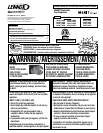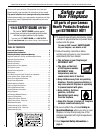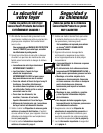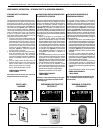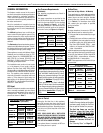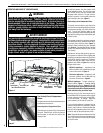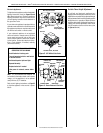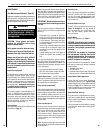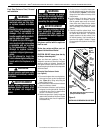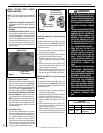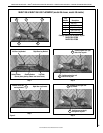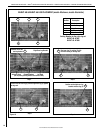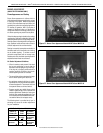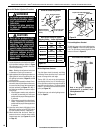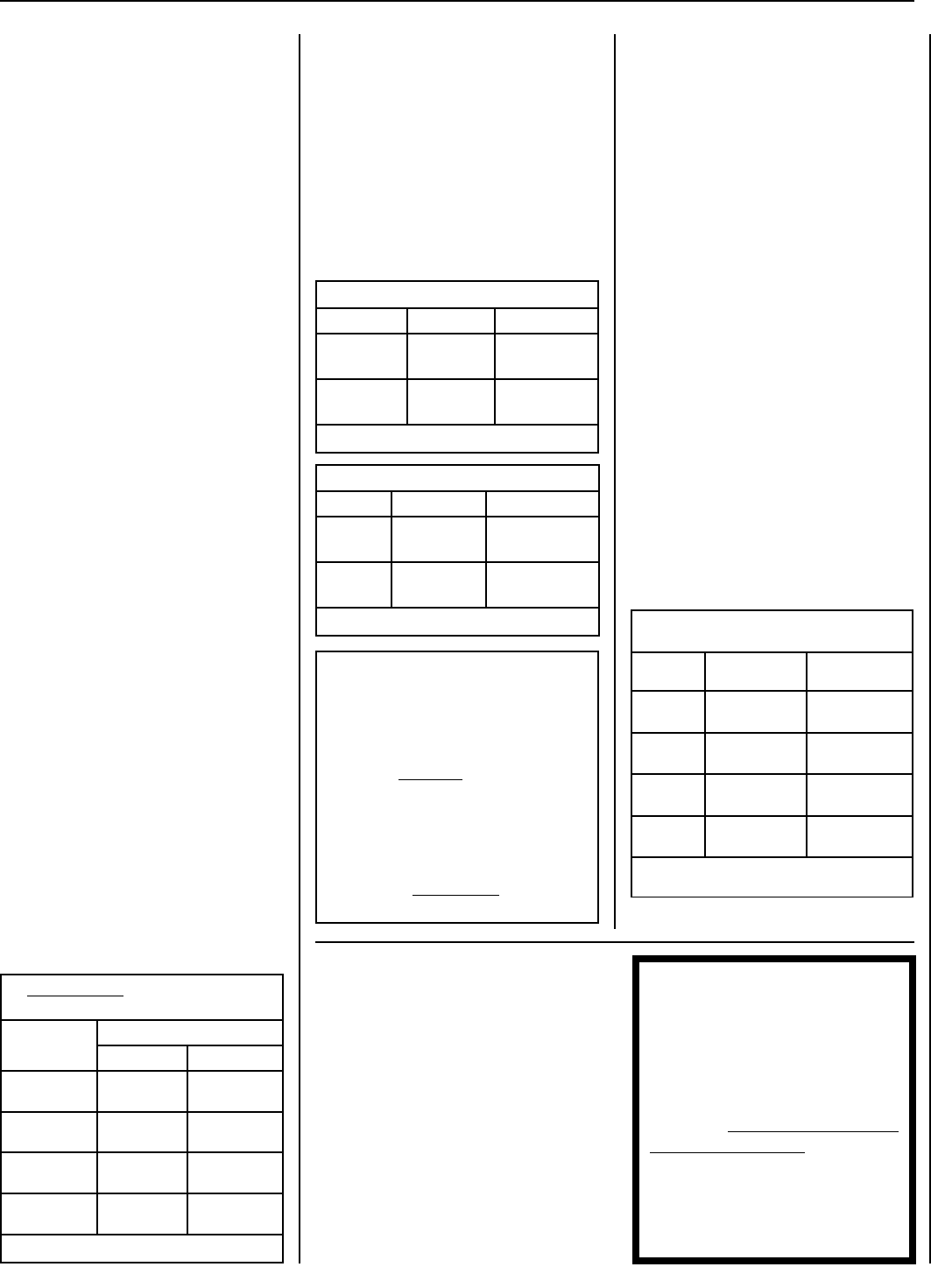
7
NOTE: DIAGRAMS & ILLUSTRATIONS ARE NOT TO SCALE.
GENERAL INFORMATION
The fireplace models covered in this manual
are direct-vent sealed combustion gas fireplace
heaters designed for residential application.
These direct-vent appliances operate with the
combustion chamber completely isolated from
the indoor environment.
All air for combustion is brought in from the
outside and exhaust gases are vented through
the same direct-vent, co-axial (intake/exhaust)
vent system.
The Millivolt appliances have a millivolt gas
control valve with piezo ignition system. If any
optional accessories which require electrical
power are being installed, the electrical power
must be provided at the time of appliance in-
stallation.
The Electronic appliances have a battery backed-
up electronic intermittent pilot system. The bat-
tery backup will allow you to continue operation
of the appliance during a power outage.
These appliances comply with National Safety
Standards and are tested and listed by ETL/
Intertek (Report No. 100326540PRT-001) to
ANSI ZZ21.88 (in Canada, CSA-2.33), and
CAN/CGA-2.17-M91 in both USA and Canada,
as vented gas fireplace heaters.
The Installation must conform to local codes
or, in the absence of local codes, with the
National Fuel Gas Code, ANSI Z223.1/NFPA
54-latest edition, or the Natural Gas and Propane
Installation Code, CAN/CSA B149.1-latest edi-
tion. The appliance, when installed, must be
electrically grounded in accordance with local
codes or, in the absence of local codes, the
latest edition of the National Electrical Code,
ANSI/NFPA 70, or the Canadian Electrical Code,
CSA C22.1 - latest editions.
LENNOX HEARTH PRODUCTS • MERIT
®
SERIES DIRECT-VENT GAS FIREPLACES • MODELS MLDVT-30/35/40/45 • CARE AND OPERATION INSTRUCTIONS
Orifice Sizes
(Sea Level to High Altitude – All Models)
These appliances are tested and approved for
installation at elevations of 0-4500 feet (0-1372
meters) above sea level using the standard
burner orice sizes (marked with an asterisk
[*] in Table 4). For elevations above 4500
feet, contact your gas supplier or qualified
service technician.
Deration
At higher elevations, the amount of BTU fuel
value delivered must be reduced by either:
• Using gas that has been derated by the gas
company.
• Changing the burner orice to a smaller size
as regulated by the local authorities having
jurisdiction and by the (USA) National Fuel
Gas Code NFPA 54/ANSI Z223.1 - latest
edition or, in Canada, the CAN/CSA-B149.1
codes - latest edition.
Install the appliance according to the regulations
of the local authorities having jurisdiction and,
in the USA, the National Fuel Gas Code NFPA
54 / ANSI Z223.1 - latest edition or, in Canada,
the CAN/CSA-B149.1 - latest edition.
NOTE: Flame appearance will diminish 4% per
thousand feet.
Burner Orifice Sizes
Elevation 0-4500 feet ( 0-1372 meters)
Model
Series
Nat.Gas
drill size (inches)
Propane
drill size (inches)
MLDVT-30
#50 (0.070")*
H4873
•
#59 (0.041")*
H7838
•
MLDVT-35
(0.0748")*
H1355
•
(0.045")*
75L10
•
MLDVT-40
#44 (0.086")*
60J80
•
#55 (0.052")*
19L52
•
MLDVT-45
(0.090")*
37L70
•
#54 (0.055")*
99K79
•
*Standard size installed at factory.
Table 4
•
Part /Cat. Number.
Inlet Gas Supply Pressure (all models)
Fuel # Minimum Maximum
Natural Gas
4.5" WC
(1.12 kPa)
10.5" WC
(2.61 kPa)
Propane
11.0" WC
(2.74 kPa)
13.0" WC
(3.23 kPa)
Table 2
Manifold Gas Supply Pressure (all models)
Fuel # Low High
Natural
Gas
(Lo) 2.2" WC
(0.55 kPa)
(Hi) 3.5" WC
(0.87 kPa)
Propane
(Lo) 6.3" WC
(1.57 kPa)
(Hi) 10.0" WC
(2.49 kPa)
Table 3
Gas Pressure Requirements
(All Models)
Gas pressure requirements are listed in
Tables 2 and 3.
Test gauge connections are provided on the
front of the millivolt gas control valve, identi-
fied IN for the inlet and OUT for the manifold
side (see Figure 3 on Page 9). A 1/8" NPT
Test gauge connection is provided at the inlet
and outlet (manifold) ports on the electronic
gas control valve (see Figure 4 on Page 9).
Input (BTU/HR) Manually-Modulated
Gas Valves (all models)
Model
Input Rate (BTU / HR)
Nat. Gas Prop. Gas
MLDVT-30
13,500 high
10,500 low
12,500 high
9,000 low
MLDVT-35
16,000 high
12,500 low
15,000 high
11,500 low
MLDVT-40
20,000 high
15,500 low
20,000 high
15,800 low
MLDVT-45
23,000 high
17,500 low
22,000 high
17,000 low
Table 1
BTU Input
Millivolt and electronic models come standard
with a manually-modulated gas valve; flame
appearance and heat output can be controlled
at the gas valve. The BTU Input for these ap-
pliances are shown in Table 1.
Burn-in Period
During the first few fires in this appliance,
there will be some odor due to the curing of
the paint and burning off of lubricants used in
the manufacturing process. Depending on your
use, the burn-in period may take a few hours
or a few days.
KEEP YOUR HOUSE WELL VENTILATED
DURING THE BURN-IN PROCESS. THE ODOR
AND HAZE EMITTED DURING THE BURN-IN
PROCESS CAN BE QUITE NOTICEABLE AND
MAY SET OFF A SMOKE DETECTOR.
If an optional blower is installed, do NOT turn
it on during the burn-in period.
IMPORTANT NOTE!
A white film may develop on the glass
enclosure panel during the first few
fires as part of the burn-in process.
The first few times you use the
fireplace, clean the glass after
each use (AFTER THE GLASS HAS
COMPLETELY COOLED); otherwise,
the white film will bake onto the
glass and become difficult to
remove.
See “Cleaning Glass” on Page 10.
These appliances must be isolated from
the gas supply piping system (by closing
their individual manual shut-off valve)
during any pressure testing of the gas
supply piping system at test pressures
equal to or less than 1/2 psig (3.5 kPa).
These appliances and their individual
shut-off valves must be disconnected
from the gas supply piping system dur-
ing any pressure testing of that system
at pressures greater than 1/2 psig (3.5
kPa).



